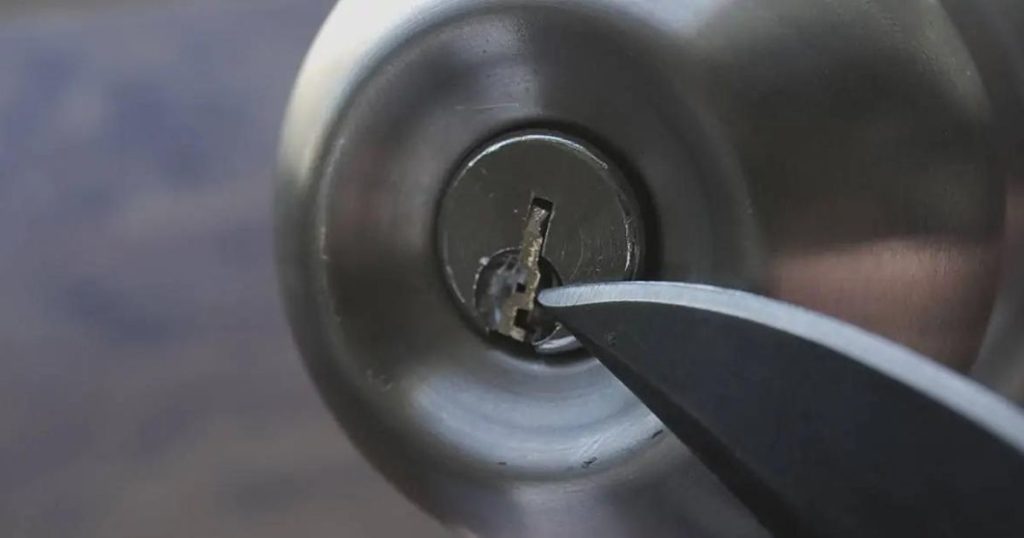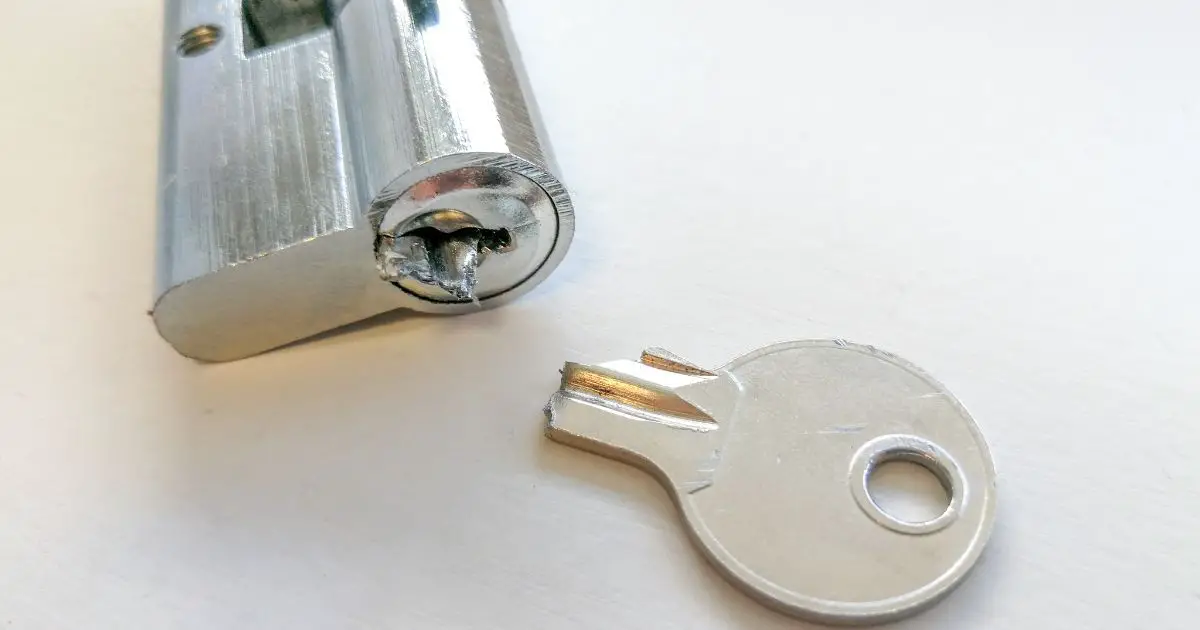Nowadays, it’s common to find yourself in a hurry, and as usual, upon facing such a hurry, something is certain to go wrong, as it almost always does.
Have you found yourself breaking off your key inside of a lock in a moment of flurry? Has the key been jammed so far inside the keyhole that your nails don’t even come close to having some form of traction with it?
Don’t worry – rather than wallowing in self-pity or calling your local locksmith, here is a list of some easy DIY methods on how to remove a broken key from a lock.
Here is a helpful list of everyday tools that you can use to slide a broken key out of your lock:
- Tweezers (make sure they have a pointy end)
- A glue stick or super glue (a blowtorch or a matchbox is required as well)
- A very thin nail or needle (pliers are also required)
- A knife
- A fishing hook (pliers are also necessary)
- A hacksaw (scissors or tin snips are required to thin them off so that they may fit inside the gap between the key and the keyhole)
Of course, none of these are required if you own a key extraction tool set. If you do own one but your key extraction tool set didn’t come with an instruction manual, this article also covers how to use the various tools inside your key extraction tool set.
Preliminary Measures
Before you start doing anything, be aware that you can make the situation worse by mishandling your tools. You could push your key further inside of the lock’s keyhole and make the situation even more difficult to resolve, so try to use a gentle hand.
Most locks come with the ability to retain keys if the key isn’t aligned properly with the keyway. The key must be vertically aligned with the keyhole otherwise the lock will retain the key and not allow it to be removed.
Make sure to use your pliers or tweezers to twist the key until it is positioned directly vertically with the lock. After that, apply a dry lubricant over the keyhole. Try to slip in some of the lubricant inside the gap between the key and the keyhole to decrease the friction between the key and the lock.
Although a petroleum-based lubricant like WD-40 will work, these oil-based lubricants tend to attract and accumulate grime and dirt which might cause unwanted long-lasting effects. Teflon and graphite powder are good solutions as their dry properties don’t have the same downsides as oil-based lubricants.
How to Remove a Broken Key From a Lock
Key Extraction Tool Set

A key extraction tool set typically consists of various tools with a lengthy, thin protrusion and either a hook or a barbed end.
By passing the key extractor through the gap between the key and the keyhole, the hook or the barbs provide traction with the key, allowing you the necessary proper leverage to pull the broken key out of the lock.
If one of the tools inside the key extraction toolset doesn’t catch and gain the required traction with the broken key, switch them out with another tool inside the key extraction tool set and repeat the process. Twist and turn until the barbs catch against one of the key incisions and then pull outwards to remove the key from the keyhole.
Tweezers or Pliers

If you have a pair of tweezers or pliers with pointy ends, you can use them to try to free the broken key from the lock.
Be sure to proceed with caution as one of the causes of keys breaking inside locks is them getting brittle with age. This could be due to poor manufacturing conditions such as the use of weak, malleable brass to construct keys for locks. Proceed with a gentle hand because too much force could lead to pieces of the key snapping and making the situation worse.
Use tweezers or pliers to grab hold of the side ends of the broken key gently. The use of thin tweezers is advisable if the broken key is buried too deeply inside the lock and pliers can’t reach or gain traction with the key.
Try shifting the broken key a bit from its original position and wiggling it around to provide the key some more room to prevent friction. After having a firm grip on both sides of the broken key, pull outwards gently. If after multiple attempts, the key refuses to be freed, try another one of the methods listed below.
Super Glue and Glue Stick

To remove a broken key from a lock with a glue stick, hold your glue stick against the keyhole and use a heat source such as a blowtorch or a matchstick to heat the end you’re holding against the keyhole.
Let it cool and harden for a few minutes before gently pulling it outwards. If everything goes as planned, the piece of the broken key will move with the glue stick. If not, give it a few more attempts, as it’s mostly a matter of luck that the glue catches with the broken key and does not let it go during the removal process.
You can also try to use super glue to remove your key from the lock, but this method is not encouraged as it can permanently damage your lock if you get super glue on the locking mechanisms. If you do try this method, use extreme caution as you can easily damage your lock if you aren’t careful.
Smear a small amount of super glue on top of the broken key. Be careful not to get super glue on the keyhole itself. Once the exposed portion of the broken key is covered with super glue, carefully attach the top portion of the key head that broke with the key stuck inside the lock.
Don’t move and let the glue harden for a few minutes so that the key head perfectly joins with the broken portion again. Once the glue hardens, carefully try to remove the key from the lock. If the key head separates from the key blade, try again and give the glue more time to harden. If everything goes well, not only will you remove your key from the lock, but you’ll also repair your key at the same time!
Knives, Needles, or Nails

If the broken key portion is sticking out slightly from the keyhole, you might not even need much effort to free it. You can use common household tools such as pointed knives, nails, or needles to remove it.
You can try using a knife to grasp the gap between the key and the keyhole to try to shimmy out the key. If this doesn’t work, you can use another knife and use a knife in both hands to pinch the key out.
You can also grab a nail with some pliers and try to hook in a key incision using the nail spirals. If all goes well, you can gently pull it out using the pliers and the key would remove itself along with the nail.
Using two needles is also a viable method for removing a broken key from a keyhole. Grab a thin, long needle in both hands and try to find the right position between both sides of the broken key. After finding the proper traction, try pulling the broken key outwards in a pinching maneuver.
This is the simplest method to free your lock from the piece of key stuck inside it.
Fishing Hook and a Hacksaw
A fishing hook has a hook that is useful in removing a broken key from its lock. By inserting the fishing hook inside the gap between the key and the keyhole, it can be easy to reach the key inside the lock.
By wiggling the fishing hook around, the hook can catch one of the incisions inside the key. After that, use pliers to grab the fishing hook and pull it outwards. Try not to use too much force as the key can get damaged or get pushed further inside which can cause unnecessary complications.
A thin piece of hacksaw strip can also be used to remove a broken key from its keyhole.
By using tin snips, you can cut the hacksaw strip to become even thinner and able to fit inside the gap between the key and the keyhole of the lock. The hacksaw’s jagged barbs can easily find traction against the key.
After that, repeat the process of pulling the hacksaw strip outwards and extracting the broken key.
Summary
It can be expensive to hire professional locksmiths when your key is stuck in a keyhole, but with this helpful list of DIY methods, and with a bit of effort, you might be able to do the job yourself.
However, if after trying all these methods, your key refuses to budge and remains stuck inside that pesky lock, it might be best to give in and use professional help.

